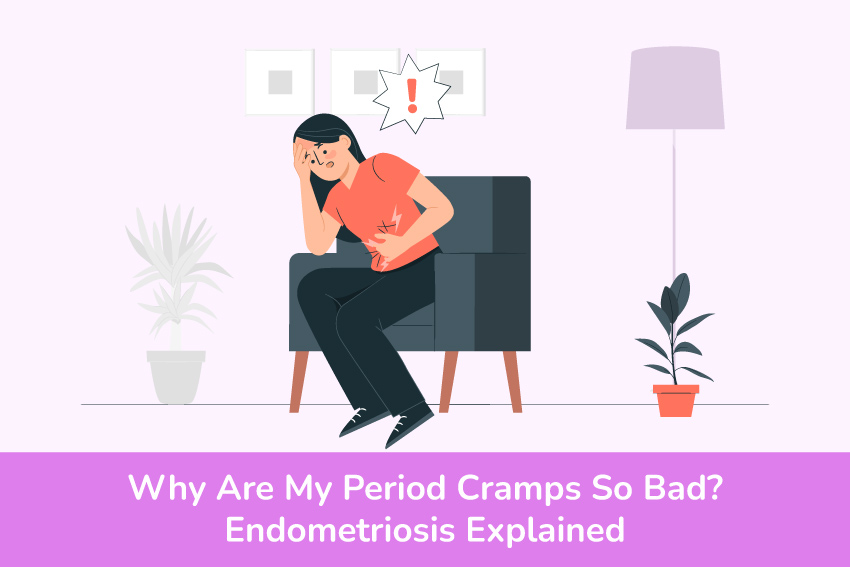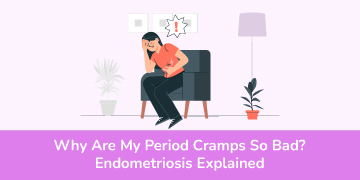
Many women experience some discomfort during their menstrual period, but when these bad cramps during the period become severe and disrupt daily life, it raises critical questions about underlying health conditions such as endometriosis. Understanding the difference between normal and concerning pain, recognising symptoms, and knowing when to seek expert help is crucial for your well-being. This comprehensive guide explores why some period pain is so severe, highlights what endometriosis truly is, and offers practical expert-backed strategies for management, prevention, and support, referencing insights from the leading private gynaecologist in London.
A] Understanding Period Pain: Normal vs. Concerning
1. Characteristics of “Normal” Period Pain:
Although mild to moderate discomfort before or during menstruation is common, “normal” period cramps usually:
- Starts just before or with bleeding and reaches its height in the first day or two.
- Respond well to over-the-counter pain relievers (NSAIDs)
- Do not disrupt the day-to-day activities
2. Red flags that indicate there is a problem include:
- Pain that is severe, debilitating and interrupts work, school, or social life
- Gradually worsening pain that does not subside in a couple of days
- Failure to respond to normal pain relief drugs
- Persistent pelvic pain outside of menstruation
These symptoms often point to an underlying condition such as endometriosis, fibroids, or pelvic inflammatory disease rather than simple menstrual cramps.
Painful periods? Learn if it’s endometriosis and get expert advice today!
B] What Exactly Is Endometriosis?
Endometriosis is a chronic, inflammatory condition in which tissue similar to the uterine lining develops outside the uterus, often on the ovaries, fallopian tubes, pelvic lining, and sometimes the bowel or bladder. This misplaced tissue reacts to the hormonal cycles every month, resulting in inflammation, scar tissue, and adhesions that cause severe pain and, in most cases, infertility. The exact cause is not clear yet, but it is common in women during their reproductive years, and it affects up to 1 in 10 women all over the world.
C] Beyond Cramps: Common Symptoms of Endometriosis
Period cramps are just one symptom of endometriosis. Other common, but overlooked or misdiagnosed symptoms include:
- Dysmenorrhea: Chronic and severe pain during the period that usually starts before bleeding and lasts longer than menstrual cramps.
- Chronic Pelvic Pain: Continuous discomfort, even in days when not menstruating, can impact the lives and mental health of the person.
- Dyspareunia: pain during or after sex, due to inflammation or scarring of the pelvis.
- Bowel and Bladder Symptoms: Painful urination or bowel movements, especially when menstruating; symptoms may mimic or co-exist with IBS, with consequent bloating, diarrhoea, constipation or in a rare instance, bloody urine or faeces.
- Fatigue: persistent tiredness aggravated by persistent pain and inflammation.
- Infertility: Up to half of the women who have difficulty conceiving have endometriosis; adhesions or inflammation can cause damage and disrupt conception.
- Other Less Common Symptoms: Lower back pain, heavy, or irregular bleeding, nausea, and mood swings.
Note that some women with regular cycles can still have endometriosis, so people who have doubts, “Can you have endometriosis with regular periods?”, the answer is yes! Though symptoms can’t always be related to the extent of the disease. If these symptoms sound familiar, find the best endometriosis specialist in a UK private clinic to help you undergo a thorough assessment.
D] The Diagnostic Journey: Getting a Diagnosis
The diagnosis of endometriosis could be challenging; it requires a multi-step approach:
- Initial Consultation: A thorough review of the symptoms, pattern and medical history by an experienced clinician
- Physical Examination: Could be helpful to detect pelvic tenderness or nodules
- Imaging Tests: Ultrasound (especially transvaginal) or MRI help to rule out other conditions, but may not be able to visualise small endometriosis lesions.
- Laparoscopy: The gold standard for definitive diagnosis has the advantage of direct visualisation and biopsy of the tissue; it often provides both the diagnosis and the treatment in a single procedure.
E] Managing Endometriosis: Treatment Options
Managing endometriosis focuses on symptom control, halting disease progression, and preserving fertility where needed. Treatment is highly individualised and may include:
1. Pain Management
- NSAIDs (e.g., ibuprofen), the first-line for mild symptoms
- Prescription pain medications for severe discomfort
2. Hormonal Therapies
- Oral contraceptives (birth control pills) are used to suppress menstruation and slow endometrial tissue growth. Many people ask, “Does the pill stop endometriosis from growing?” The answer is “It may reduce progression but is not a cure.”
- Progestins and IUDs (hormone-releasing intrauterine devices) can effectively minimise pain and bleeding
- GnRH agonists/antagonists lower estrogen to induce temporary menopause, reducing growth and pain (for short-term use)
3. Surgical Options
- Laparoscopic excision to remove implants and relieve pain, preserve organs, and address infertility
- Hysterectomy is rarely considered and only in refractory, severe cases where childbearing is complete
4. Complementary Approaches
- Acupuncture, dietary changes (anti-inflammatory foods such as fruits, vegetables, omega-3-rich foods), and stress management (yoga and mindfulness) may help, but consult your provider first
- Physiotherapy can address pelvic floor dysfunction
A multi-layered approach is optimal; for expert and integrated care, contact Mr Nilesh Agarwal, a private gynaecologist in London.
F] Living with Endometriosis: Coping Strategies and Support
People who are unsure about “How to prevent endometriosis?” Below are a few tips and coping strategies to support living with it:
1. Self-Care and Lifestyle Adjustments:
- Appreciate the impact of diet, focus on anti-inflammatory foods, cut down on red meat, and consider omega-3 supplements
- Maintain regular exercise to support overall health and mood
- Prioritise stress reduction through mindfulness, meditation, or yoga to manage pain perception
2. Emotional and Psychological Support:
- Therapy and counselling provide tools for dealing with chronic pain and fertility concerns
- Involvement in in-person or online support groups encourages shared understanding and advocacy (see our Myths about endometriosis )
For a confidential appointment, our private gynaecologist in London is ready to offer expert diagnosis and compassionate support focused on your specific needs.
Looking for a Private Gynaecologist in London?
Conclusion
Severe or bad cramps during the period are never something to dismiss, especially if they limit your quality of life, persist despite treatment, or come with additional symptoms like pain with sex, bowel movements, or chronic fatigue. Endometriosis is common, complex, and, with the right multidisciplinary care and lifestyle adjustments, manageable. If you suspect endometriosis or any women’s health issues, seek an appointment with an expert gynaecologist who can improve outcomes by addressing concerns early.

Neha Goel
Neha Goel, a Psychology alumna and MBA graduate from CASS Business School, London, brings together her expertise as a Reiki Practitioner and Practice Manager. She integrates psychology and business strategies to foster holistic well-being and personal development.

